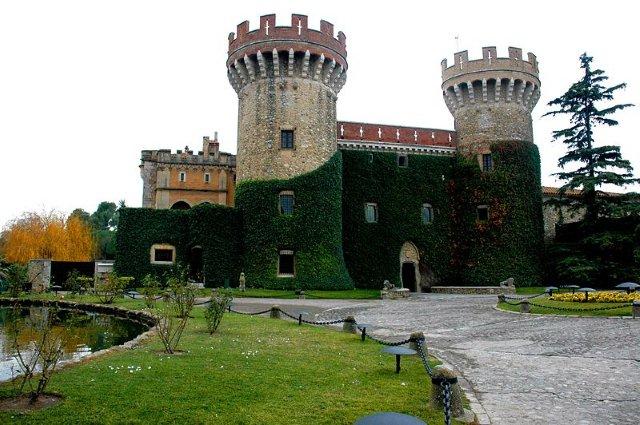| Peralada | |
|
|
|
|
1/2 Day |
|
|
The
history of Perelada dates back to approximately 500 b.C, when members of
the Iberian tribe called the Indigetes
built the first walled town on this site. In the 9th Century the town was
the centre of one of the most important counties in the Carolingian Empire
and became a significant town of the Ampurdan during the Middle
Ages. The medieval town structure is still well preserved today and is
reflected in the ancient street names. Peralada
Castle. - Very few locations in this country have an artistic and cultural scene
equal to that offered by the town and its celebrated Castle of Peralada.
Of Mediaeval origin, with an exceptional Renaissance façade with neo-Gothic
elements, its twin towers have become a symbol of the town. It was built
by the Viscounts Rocabertí, who was "promoted" to Counts in
1599. The name of the Rocabertí family is evoked in "Don Quixote"
as one of the great, ancient lineages of Catalonia. In one of its wings
Perelada Castle has a well-known gambling casino, and it is also the site
for the Perelada Castle International Music Festival. The beauty of its
salons and gardens and its high-quality services have made this privileged
location the ideal place for celebrations and conventions. Over the
Christmas season the castle gardens are also the scene of the
representation of the Living Crib of Perelada, one of the town's most
time-honored traditions and one with the greatest
involvement on the part of its inhabitants. Perelada Castle Museum Museums
and art collections are an additional attraction in Perelada. These are to
be found inside the old 14th century El Carme convent. The church and
cloister are the two original parts of the monastery that you can still
visit. The church of El Carme, in the Gothic style, was restored at the
end of the 19th century. The altar is decorated with silver elements from
the 17th and 18th century Cordova School. At present the church is used
for religious ceremonial and as the site for chamber music concerts, as
well as lyric recitals and solo performances in the Perelada Castle
International Music Festival, because of its priceless acoustics. The
perfectly preserved Carme cloister leads to the Stained Glass Museum (Museu
del Vidre), which contains one of the world's largest private
collections. Consisting of about 2,500 works, it was put together mostly
in the Barcelona antiques trade, so the finest and most abundant examples
are Catalan. The south-eastern part of El Carme convent houses the
Perelada Castle Library. Built originally in 1888, it is one of the castle's most famous and most important cultural elements. Miquel Mateu, an enthusiastic collector, purchased numerous volumes all throughout his life. At present there are over 80,000 volumes. It contains first editions, unique or extremely rare editions, manuscripts, letters patent of nobility and the famous Cervantine collection with over 1,000 different editions of Don Quixote. The oldest printed book in the collection has the title “Sermons de Robertus Caracciolu” and this was printed by Francisco de Formis in Venice in 1472. The library and archive are open to researchers. This location, which radiates beauty, culture and knowledge, as well as inviting meditation, is also the setting for many civil weddings. In the underground cellars of the old convent of Carmelite monks you will see the Wine Museum (Museu del Vi). All the elements and objects on display have something to do with the culture of wine in all its facets. All the way from an ancient wine press in which the grapes were trodden at harvest time, cork cutters, wineskins, an exceptional collection of 18th century porrons (vessels with jets for drinking wine) to a re-creation of a rustic dining-room of the period. The way out of the Museum is through the original cellar in which the Gran Claustre cava is still elaborated in the traditional craftsman's manner.
|
|
